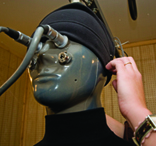Warm and woolly
Professor's research aims to standardize the ratings used by consumers to choose adequate outerwear for the winter season
 When buying a winter coat in a store, online or from a catalog, shoppers can get a pretty good idea of what the garment looks like. Knowing how warm it will keep them, however, takes guesswork.
When buying a winter coat in a store, online or from a catalog, shoppers can get a pretty good idea of what the garment looks like. Knowing how warm it will keep them, however, takes guesswork.
Manufacturers put temperature ratings on jackets, coveralls and other such products, said Elizabeth McCullough, K-State professor of textiles and co-director of the Institute for Environmental Research. She said manufacturers have different methods to determine those temperature ratings.
"At K-State, we do most of the testing for manufacturers like The North Face and L.L. Bean, but everybody wants it done a different way," McCullough said. "One may do the testing of a jacket worn over a lightweight ensemble, the other over a heavyweight ensemble. Other manufacturers may put a range of comfort based on the person's activity level while wearing it."
McCullough is chairing a committee of the American Society for Testing and Materials to develop a standard formula for determining the temperature ratings for cold-weather clothing. The goal is to have all manufacturers doing the same testing so a consumer can compare one product to another. McCullough said this would be particularly helpful to consumers who can't try on the garment because they're shopping online or from catalogs.
"What we're trying to do is to guide people in the purchasing process; to help them meet their needs at the point of sale," McCullough said. "The other thing is to provide safety. We're trying to prevent people from getting into a hypothermia situation by letting them know a garment can keep them warm down to a certain temperature."
A temperature rating is the lowest temperature at which a consumer can be comfortable when wearing outdoor clothing. McCullough's work involves first measuring the insulation value of a cold-weather ensemble with a thermal manikin and then using the value in a whole body heat loss model developed by Steve Eckels, K-State professor of mechanical engineering and director of the Institute for Environmental Research. The model assumes all other variables, like relative humidity and wind speed, are the same. The clothing worn underneath the jacket during testing has to be the same, too.
"One thing consumers need to realize is that the ratings are not just for the garment -- they're for the whole ensemble," McCullough said. "You're not going to be comfortable if you're only wearing the jacket."
How comfortable you are in a garment depends on the outside environment, the clothing worn and the activity level of the person.
"The more active you are, the more metabolic heat you produce," McCullough said. "You don't need as much insulation to keep you comfortable. In that way, it's easier to test a sleeping bag because your activity level is going to stay the same. But for a jacket, someone could be sleeping in it, doing hard labor in it or just walking. The comfort level is going to change drastically."
Researcher offers tips on dressing for the cold
Photo: Meet Stan, an integral member of Professor Elizabeth McCullough's research team. STAN is equipped to measure just how well a piece of winter clothing protects its wearer from the cold.